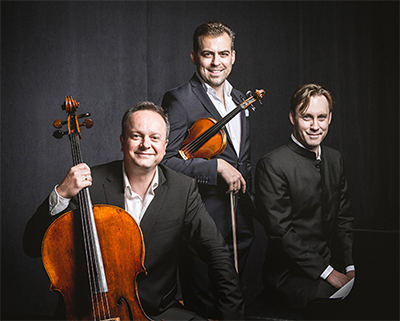by Nicholas Stevens

The German trio’s program on February 10, focused on monuments of Central European Romanticism, brought a weight and seriousness to the Rocky River Chamber Music Society’s season that did not stifle enjoyment. On the contrary, their traditionalism of repertoire, demeanor, and even attire — sharp black suits with glossy shoes — felt fresh.
The particular satisfaction of the concert’s first bars arrived at the intersection of motion and space. The brick box of West Shore Unitarian Universalist Church’s sanctuary can amplify loud sounds past the point of pleasure, but here worked perfectly to reveal this ensemble’s uncanny unity. Their confidence and togetherness made the first movement of Beethoven’s Trio in D (“Ghost”) a joy to hear. In the first three minutes alone, violinist Friedemann Eichhorn and cellist Peter Hörr used more styles, sizes, and speeds of vibrato than some manage in an entire concert, all responsive to the unique demands of every note. Also a thrill to watch, they moved freely and checked in with one another often, glued not to their stands but to one another.
Husky, mournful tones colored the opening of the second movement an autumnal shade. In this movement, the ensemble’s overarching aesthetic became clear. Allowing unexpected or pivotal harmonies to blossom dramatically, the Phaeton also keep their expression in check for long enough stretches that moments of high emotion — such as the climax of this famously dark movement — become riots of floral excess at the centers of shadowy canvases. Pianist Florian Uhlig made the recurring trills of the ending sound worlds apart each time they appeared. In the third movement, the Trio members shouted their joys to the heavens, throwing caution to the winds at chosen moments.
Hörr’s solo opened Mendelssohn’s Trio in d like a Romantic song narrator singing softly and sadly at the side of a forest brook. His presence colored the rest of the movement, the noise of his bow attacking the string gloriously physical, and the sound of his low strings powerful enough to make one wonder why we ever needed double basses.
Uhlig’s personality as a chamber musician became clearer in the second movement. Mostly keeping out of the way, he revealed his unique power in the group by teetering on the edges of resolutions, making certain cadences feel like standing tiptoe on the lip of a canyon. The players tap-danced through Mendelssohn’s tricky rhythms in the scherzo, but took the finale seriously, speeding along toward the final cadence in a carefully gauged sequence of escalations.
Thrilling though some of its moments are, Dvořák’s Trio in e (“Dumky”) makes for a difficult closer. Its idiosyncratic form, which gave these players chances to find textures that were glossy, lush, and somehow both at once, offers little sense of directed intensification toward a goal. A feature rather than a bug in the piece’s design, after Beethoven and Mendelssohn’s grand edifices, this suspension of the normal order felt like an indulgence. Nevertheless, the players made the most of Dvořák’s excursions into folksy energy, embracing the trace of showmanship that the piece’s splashiest moments virtually mandate.
An encore, the slow movement from Beethoven’s Trio in B-flat, Op. 11, retained a bit of the looser feel that arrived with the Dvořák piece — fitting, perhaps, for a tune that resembles Happy Birthday. It brought an already appreciative audience to its feet.
Published on ClevelandClassical.com February 24, 2020.
Click here for a printable copy of this article


